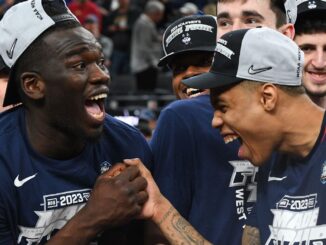
When my wife was pregnant with my future child, I decided to do the right thing and sign up for a dad’s class at the local hospital. I wasn’t overly worried about becoming a father, but I wanted to make sure there was no stone left unturned, nothing I could have done in preparation that I didn’t.
This was over five years ago now. The class was only two hours, and while most of it was unremarkable, the moment that will remain with me for the rest of my life was when the instructor encouraged us all to leave basketball off the television in the delivery room. “There are more delivery room fights during March Madness than any other time,” he cautiously proclaimed.
Everyone in the room laughed. But it was knowing laughter. How easy to imagine these fights!
My daughter was born on March 29, 2014, and while I can’t honestly say that no basketball games graced the airwaves that long weekend, I can proudly proclaim that no spousal fights were had. Checking the brackets, in fact, was a blessed reprieve during the hours of waiting!
This is a glorious time of year for basketball fans. The tournament has been front and center for two weeks, and with the women’s and men’s Final Four squads in place, next weekend’s games should offer another handful of two-hour time blocks to justify time spent on the couch.
Specifically, how wonderful for us in the Northwest to have the Oregon Ducks in the women’s Final Four for the first time, especially after making the regional final but falling short the past two seasons.
Sabrina Ionescu is rapidly making a case to become the next great WNBA star, and next Friday’s Oregon game will hopefully receive the kind of media attention it rightfully deserves. How amazing would it be if “Bazooka mode” results in another triple-double in front of a national audience—in the Final Four, no less.
Along with the Final Four, the NIT is wrapping up this week, and NBA teams are desperately vying for playoff position, from top to bottom throughout both conferences. It is truly a dreamy time of year for basketball fans.
Nevertheless, if you are nervous about all the time you are spending in front of the television, or even more importantly, nervous your aspiring basketball children are wasting away in front of the tube, I have a solution.
Released during March Madness 2014 (only a week and a half before my daughter was born!), Kwame Alexander’s The Crossover offers a story, in verse, about a pair of twin teenage basketball phenoms during their middle school basketball season.
Josh Bell (the narrator) is the star forward and Jordan Bell (his twin) the star shooting guard (I’m guessing Alexander did not know at the time about the former Oregon star, now Golden State Warriors reserve, of the same name). Their father is a former basketball great, their mother the Assistant Vice Principal at their school.
The story-in-poems takes you through all the trials and tribulations middle school can bring about, such as girlfriend drama, sibling arguments, cheating accusations, and classroom note passing. But the book dives deeper than that. The boys’ father gets progressively sicker yet refuses to visit the doctor. The family appears to have secrets the boys are unaware of.
The majority of the poems, however, embody the game of the basketball, and this will be the most attractive part of the book to any youth sports fan who picks it up. Alexander writes poems that attempt to actually describe the feeling of dribbling, crossing over, flying in for the dunk, or swishing a three. Moreover, the book is told from a youth’s perspective, as if the main character were the one writing the poems.
I remember distinctly reading books about youth sports from a young person’s perspective when I was a kid and the profound effect those books had on me. This book has likely had the same effect on many young kids today, especially aspiring basketball players, and the book was rewarded for its efficacy in this regard with numerous awards (including the Newbery Medal and Coretta Scott King Honor).
Additionally, Alexander’s playfulness with the fonts and shapes of the poems would assuredly be eye-opening to any young person that hasn’t encountered that kind of writing before.
While the book only scratches the surface of some of the themes it pursues, this makes sense for its intended audience. Moreover, Alexander acknowledges this throughout, in ways such as repeatedly defining some of the more difficult words, in a back-and-forth question session between Josh Bell and his father, in a list of basketball rules filtered throughout the text.
One interesting way to think about this book is to consider it capitalizing on the contemporary trend toward hybrid and mixed-genre work, while creating such a text accessible to youth. It’s a noble and successful attempt by Alexander, even if the book doesn’t hold the attention of adults the way the most popular young adult literature might.
While I don’t want to give away the plot elements for anyone who might read the book, I can tell you that I found myself engagingly turning the pages, imagining my five-year-old reading this book five years from now, turning the pages as quickly as her eyes allow, in suspense of both the games and the lives of Alexander’s creations.
Finally, how wonderful that Alexander’s book has received such accolades, given its atypical nature for young adult literature, and its use of basketball as its primary subject.
So if you are in need of a strategy to get your family away from the tube this final college basketball weekend, before the long slog of the NBA playoffs, pick up a copy of Alexander’s The Crossover to offer your children as bait.




